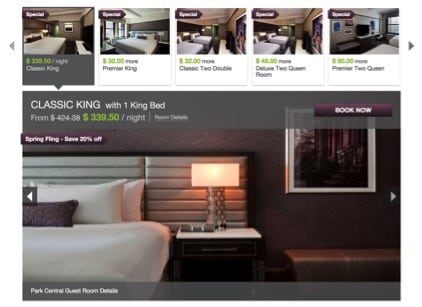Skift Take
Consumers are faced with more options during travel booking than ever before, a near overwhelming amount that can be cause to abandon purchases. Smart travel marketers are finding that reducing choices actually increases conversions.
This sponsored content was created in collaboration with a Skift partner.
There’s a famous marketing experiment by psychologists Sheena Iyengar and Mark Lepper in which the two set up a tasting booth at a market to sell jam. The first week they offered 24 flavors of jam, the following week they offered six.
With 24 flavors, 60% of the store’s customers stopped to taste test and 3% of the tasters bought jam. With six flavors, 40% of the store’s customers stopped to taste test, but 30% of those tasters bought jam. Customers were ten times more likely to buy when offered less flavors.
It’s the Paradox of Choice—more options attract more potential customers, but too many options can overwhelm consumers and cause them to abandon the purchase. The inverse is also true: studies have shown that reducing choices increases conversions.
Many hotels are caught in this dilemma when it comes to website bookings. With multiple room types, each with their own set of rates and packages, the number of booking options can easily top 50 or more. And that doesn’t factor add-ons such as parking or airport transfer, which can make the list even longer.
Because hotels have an inflexible inventory (there’s no way to convert a standard room into a suite, for example) reducing options is difficult and oftentimes not possible. However, a few simple strategies can help to prevent losing potential guests during the booking process:
Split the decision-making process into multiple steps
On most hotel websites, travelers enter dates, then the booking engine displays all available options in the search results. If a hotel has five room types and eight rate plans, the traveler would see 40 different options on a single page.
Instead of overwhelming the potential guest with all the available options, hotels should split the booking process into smaller, more digestible steps—allow the traveler to select only the room type first, then offer the various rate plans and add-ons in the next step. Decision-making becomes easier for the guest and increases the chance of conversion.
Mayfair Hotel & Spa in Miami, which offers nine room types and various rate plans based on seasonal travel packages, switched to this two-step booking process in late 2014. Within five months the hotel saw its conversion rates jump 64% year over year, resulting in a 66% increase in revenue.
Minimize add-ons during booking
Following suit with the airline industry, which has seen success upselling premium seats and travel insurance to customers booking flights, the hotel industry has made add-ons a common part of the booking process. But actual booking data shows that only 3% of guests actually purchase add-ons, and the money earned from them represents an average of 0.1% of the total revenue.
Though hotels may think they have nothing to lose by offering add-ons, a long list of them simply adds another set of choices for consumers, which may increase the chance of booking abandonment. As the data shows, the incremental revenue earned from add-ons during the booking process is too small to make up for any loss any conversions.
Hotels should either keep add-ons to a minimum, or better yet, wait to present them until after the reservation is complete. A number of sophisticated pre-arrival marketing tools are now available to reach out to guests just prior to their stay to promote upgrades and other services.
Always pre-select a default
In marketing, the default effect is a powerful one. Whenever a default is pre-selected, research shows that not only do the majority of people go along with the default, that option becomes a standard by which all other options are judged.
Hotels can use this to their advantage by offering their lowest available room rate as a default option—this is typically a standard room that is booked the most frequently. The benefits are two-fold: first, it eliminates any barriers of decision-making for customers who simply want the cheapest option, and second, it gives a point of comparison to more expensive rooms. Hotels can even go a step further and show travelers the price difference between the default option and an upgraded room.
Ultimately, the paradox of choice is not so much about a magic number of options so much as it is about simplifying the decision process for consumers. Understanding the psychology behind this, as well as how to use it to your advantage, can greatly improve your hotel’s conversion rates.
To learn more about potential conversion killers on your hotel website, visit Travel Tripper to access their free e-guide:
Learn More
Have a confidential tip for Skift? Get in touch


